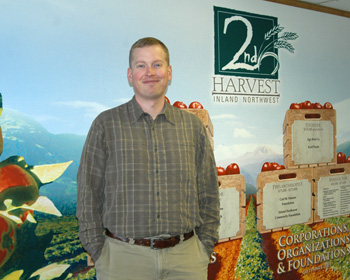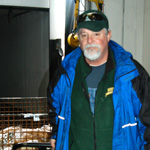Second Harvest donors rise to meet increase in need
Anticipating that 2009 and 2010 will be challenging economic years for individuals and organizations, Jason Clark expects generous people will try to meet the more than 20-percent increase in food bank clients.
 |
| Jason Clark expects to weather the economic downturn |
“The food bank system will be put to the test. We will do what we can to be sure it has the resources and infrastructure to meet the needs,” he said from his more than six years experience as executive director of Second Harvest Inland Northwest.
Second Harvest’s primary hunger-relief program in Spokane County is the Outlet System, a network of 20 food banks serving families in the county. They define service areas by zip codes and streets. Centralized generation of resources means they receive food from Second Harvest based on the number of clients served.
Washington Emergency Food Assistance Program, which welcomes such networking, distributes up to $8 million per biennium across the state.
“We use the state grant to leverage other resources,” Jason said.
Food banks, which vote on how to use the grant, have chosen for more than 20 years to have Second Harvest use the grant to provide food for each outlet.
Donations from corporations—such as the food industry giving unmarketable products—and from individuals, who drop food items in collection barrels, support events like Tom’s Turkey Drive or give money, supplement the grant.
In 2009, Jason expects Second Harvest will distribute 4 million pounds of food to the outlets—that’s 16 pounds of food for every $1 of the state grant.
“We provide an efficient way to move food in the community,” he said. “Next year we will work to provide more resources to meet the growing demand. We are bringing as many resources as possible into the community. It takes coordination and partnerships to pool resources and share costs.”
Second Harvest grew from roots as the Spokane Food Bank, which had a early distribution center on W. Maxwell. Now Second Harvest has a warehouse at 1234 E. Front.
“We are grateful to have the network in this time of increased need and shrinking resources,” he said. “Working together, we can weather the storm, supplying more food to food banks.”
Jason, who began food bank work as a volunteer out of college 15 years ago, said Second Harvest will learn more through its annual client survey in August.
Eleven of the 20 food banks are in churches or with programs sponsored or started by churches working together.
The largest provider, the Salvation Army, serves as a county-wide food bank. It and other food banks serve people who come and then refer them to the neighborhood food banks.
“We have the network so no one agency is overwhelmed and to assure that we serve the most people possible,” Jason said.
“The goal in 2010 is to generate at least 10 percent or 400,000 pounds more food. It may not meet the full need,” he recognized, “but it’s a challenge in an environment of uncertainty about grants and corporate donations.
“Spokane is always a generous community. We will reach the goal, especially with the help of churches doing food drives and raising cash contributions.”
One partner, Thrivent Financial for Lutherans, has made possible the Mobile Food Bank program, now in its third year. They purchased a 26-foot refrigerated truck to transport perishable foods to neighborhoods for immediate distribution. The food is lowered on the liftgate and set on tables outdoors for distribution.
A church that requests the mobile food bank recruits 20 volunteers and pays $500 to transport the food. If there’s a food bank at the site, the church partners with it to hold a two-hour outdoor food distribution of about 10,000 pounds of produce and perishables donated by wholesalers, packing houses or farmers.
The Mobile Food Banks usually serve 200 to 300 families.
Second Harvest arranged 60 distributions this year—giving out 500,000 pounds of food.
Thrivent has mobilized Lutheran churches to sponsor outdoor food banks at their churches or in high-need areas.
“Local food banks generally do not have the ability to store perishable food,” Jason said. “Right now, farmers have donated many apples because over-production led to a drop in prices.”
 |
| Larry Johann unloads Thrivent Truck from Grocery Rescue program |
Churches also have helped recruit many of the 2,200 volunteers who gave 50,000 hours in 2008. Volunteers make food collections and distribution possible. For example, volunteers have recently sorted donated apples, taking out damaged and bruised ones, and packing the good ones in boxes.
“The faith community is generous with its time, interest and involvement,” Jason said.
Another new program is Kids’ Café, part of a national program through Feeding America, which sponsors 2,000 sites across the United States. Second Harvest applied for a grant to start one through the Northeast Youth Center at Hillyard Baptist Church for students in K-8 after school every day until 6 p.m.
About 150 children came during the school year and 300 in the summer. The Northeast Youth Center collaborates with other nonprofits to provide child care, tutoring, sports and activities for low-income children in high-needs areas.
Second Harvest plans to launch two more Kids’ Cafés in 2009—one in West Central Spokane and one in Cheney.
“We are open to partnerships with churches and other organizations to start more programs,” he said.
The Kids’ Café partners with the Washington State University Extension Service to provide education on nutrition both through the nutritional content of food provided and by teaching children to make good food choices.
Second Harvest purchased a double-door refrigerator to store the food, prepared ahead and shipped to the site each week. While meals now are sandwiches, fruit and yoghurt, Jason hopes to provide hot meals.
Other Second Harvest programs include the following:
• Food $ense, started in 2004 with federal funds, is a collaboration between Second Harvest and Washington State University Extension in Spokane County. Through 17 partner agencies, it offers classes to teach low-income families and seniors how to eat healthy meals on a shoestring budget to make the most of emergency food supplies.
• The Commodity Supplemental Food Program (CSFP) provides additional nutrition to ensure the healthy growth and development of young children and to protect elderly people from the health risks associated with malnutrition. Second Harvest is the largest CSFP provider in the state with a caseload of 1,350.
• Plant A Row for the Hungry encourages people with gardens to dedicate a row of fruit or vegetables to help feed people in need. It works with local farmers’ markets, farms and orchards to collect unsold, wholesome produce for local hunger-relief efforts. Gardeners donate their surplus from 9 a.m. to 5 p.m., Mondays through Fridays at Second Harvest or other local hunger-relief organizations.
• The Food Bank University provides partner agencies with classes to help them modernize emergency and supplemental food distribution practices to serve their neighborhoods.
Second Harvest’s service area spans more than 51,000 square miles in 26 counties.
For information, call 534-6678 or visit www.2-harvest.org.
Copyright © May 2009 - The Fig Tree




